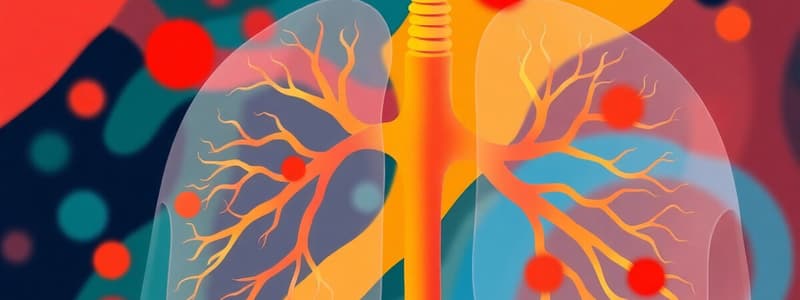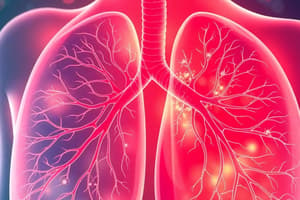Podcast
Questions and Answers
Which receptor mediates bronchoconstriction in the lungs?
Which receptor mediates bronchoconstriction in the lungs?
- M4 receptor
- M1 receptor
- M3 receptor (correct)
- M2 receptor
What is the role of M2 receptors in the lung autonomics?
What is the role of M2 receptors in the lung autonomics?
- M2 receptors delay bronchoconstriction
- M2 receptors inhibit the secretion of acetylcholine (correct)
- M2 receptors increase mucus production
- M2 receptors promote bronchoconstriction
What is the effect of acetylcholine binding to mAchR3?
What is the effect of acetylcholine binding to mAchR3?
- Inhibits mucus secretion
- Promotes bronchodilation
- Causes bronchoconstriction (correct)
- Activates calcium channels
Which of the following is a characteristic of atropine as it relates to muscarinic receptors?
Which of the following is a characteristic of atropine as it relates to muscarinic receptors?
How do B2-adrenergic receptors promote bronchodilation?
How do B2-adrenergic receptors promote bronchodilation?
What is the primary action of anti-cholinergic drugs in relation to airways?
What is the primary action of anti-cholinergic drugs in relation to airways?
Which of the following describes the function of Gq coupled M3 receptors in airway smooth muscle contraction?
Which of the following describes the function of Gq coupled M3 receptors in airway smooth muscle contraction?
What effect does the activation of muscarinic M2 receptors have on acetylcholine release?
What effect does the activation of muscarinic M2 receptors have on acetylcholine release?
What is the primary benefit of using ipratropium in comparison to atropine?
What is the primary benefit of using ipratropium in comparison to atropine?
Which adverse effect is least commonly associated with anticholinergic drugs?
Which adverse effect is least commonly associated with anticholinergic drugs?
What makes tiotropium more effective than ipratropium in terms of receptor specificity?
What makes tiotropium more effective than ipratropium in terms of receptor specificity?
Which mechanism best describes how M3 receptors mediate bronchodilation?
Which mechanism best describes how M3 receptors mediate bronchodilation?
What characteristic of tiotropium contributes to its long duration of action?
What characteristic of tiotropium contributes to its long duration of action?
How does the introduction of a quaternary ammonium group affect anticholinergic drugs?
How does the introduction of a quaternary ammonium group affect anticholinergic drugs?
Which statement accurately describes the difference between M2 and M3 receptors in the context of bronchial smooth muscle?
Which statement accurately describes the difference between M2 and M3 receptors in the context of bronchial smooth muscle?
What is the primary action of beta-2 receptors in the lungs?
What is the primary action of beta-2 receptors in the lungs?
Flashcards
What makes ipratropium less likely to cause systemic side effects?
What makes ipratropium less likely to cause systemic side effects?
Ipratropium is a quaternary ammonium derivative of atropine, which means it has a positive charge. This charge limits systemic absorption when inhaled, reducing the risk of side effects.
How does tiotropium differ from ipratropium in terms of half-life and receptor specificity?
How does tiotropium differ from ipratropium in terms of half-life and receptor specificity?
Tiotropium has a longer half-life than ipratropium, meaning it stays in the body longer. It also has a functional specificity for M3 receptors, which are important for bronchodilation, compared to M2 receptors.
How do antimuscarinic drugs achieve bronchodilation?
How do antimuscarinic drugs achieve bronchodilation?
Antimuscarinics, like ipratropium and tiotropium, block muscarinic receptors, which are involved in bronchoconstriction. This blocking action leads to bronchodilation, opening up the airways.
What are some potential adverse effects of antimuscarinic treatment?
What are some potential adverse effects of antimuscarinic treatment?
Signup and view all the flashcards
How does the introduction of a quaternary ammonium group affect the absorption and side effects of anticholinergic drugs?
How does the introduction of a quaternary ammonium group affect the absorption and side effects of anticholinergic drugs?
Signup and view all the flashcards
Which anticholinergic drugs show selectivity for M3 receptors, and what is the significance?
Which anticholinergic drugs show selectivity for M3 receptors, and what is the significance?
Signup and view all the flashcards
How do beta 2 agonists work in the context of bronchodilation?
How do beta 2 agonists work in the context of bronchodilation?
Signup and view all the flashcards
How does degradation by esterases affect the half-life of different antimuscarinic drugs?
How does degradation by esterases affect the half-life of different antimuscarinic drugs?
Signup and view all the flashcards
Autonomic Nervous System (ANS) and Airway Control
Autonomic Nervous System (ANS) and Airway Control
Signup and view all the flashcards
M3 Receptors and Bronchoconstriction
M3 Receptors and Bronchoconstriction
Signup and view all the flashcards
Muscarinic Agonist: Muscarine
Muscarinic Agonist: Muscarine
Signup and view all the flashcards
Nicotine and Non-specific Agonism
Nicotine and Non-specific Agonism
Signup and view all the flashcards
Anti-cholinergics and Bronchodilation
Anti-cholinergics and Bronchodilation
Signup and view all the flashcards
Beta-2 Adrenergic Receptors (β2-ARs)
Beta-2 Adrenergic Receptors (β2-ARs)
Signup and view all the flashcards
Atropine: A Muscarinic Antagonist
Atropine: A Muscarinic Antagonist
Signup and view all the flashcards
PKA Pathway and Airway Relaxation
PKA Pathway and Airway Relaxation
Signup and view all the flashcards
Study Notes
Pulmonary Autonomic Pharmacology
- This lecture covers the pharmacology of the pulmonary system's autonomic nervous system.
- It focuses on the effects of acetylcholine (ACh) and the sympathetic nervous system, particularly beta-2 agonists, on bronchconstriction and bronchodilation.
PNS, Acetylcholine, and Bronchoconstriction
- The parasympathetic nervous system (PNS) causes bronchoconstriction.
- Acetylcholine (ACh) is the primary neurotransmitter released by vagus nerve fibers.
- Cholinergic neurons release ACh onto smooth muscle cells via muscarinic receptors (M3 AChR) in the airways.
- This leads to bronchoconstriction.
- M2 receptors on preganglionic neurons inhibit ACh release, mitigating bronchoconstriction.
Bronchoconstriction and Bronchodilation
- Bronchoconstriction and bronchodilation work similarly to vasoconstriction and vasodilation in vascular smooth muscle.
- This mechanisms regulates smooth muscle in the airways.
Muscarinic and Nicotinic AChRs
- Muscarine and nicotine are non-specific agonists for ACh receptors.
Lung Autonomics- PNS
- M1, M2, M3, M4, and M5 receptors are present in the lungs.
- Preganglionic M2 receptors inhibit ACh release, decreasing bronchoconstriction.
- M3 receptors mediate bronchoconstriction and increased mucus secretion.
- Anticholinergics are used to dilate bronchioles and diminish mucus production.
Bronchodilators
- ACh binding to M3 AChR causes bronchoconstriction.
- Promoting dilation necessitates a muscarinic antagonist.
The M3 Receptor (Gq Coupled)
- The M3 receptor (Gq coupled) controls bronchiolar smooth muscle contraction.
- ACh binding to M3 receptors activates a signaling cascade leading to muscle contraction.
- This cascade involves the activation of PLC that hydrolyzes PIP2.
- This generates IP3 and DAG, which increase Ca2+ influx and initiate contraction.
M2 AChR Receptors Inhibit ACh
- Bronchodilators bind to M3 AChR, causing bronchoconstriction.
- M3 AChRs are found on airway smooth muscle.
- ACh binds to M2 AChRs on neurons, decreasing ACh release.
B2-AR Promote Bronchodilation
- B2-ARs promote bronchodilation, similar to vascular dilation.
- Activation of B2-ARs increases cAMP production and reduces MLC phosphorylation, leading to smooth muscle relaxation.
- Agonists are used to promote bronchodilation.
- Similiar mechanisms exist in vascular dilation.
Atropine
- Atropine, a muscarinic antagonist, blocks all muscarinic receptors, including M3 and M2 receptors (doesn't have selectivity)
- Results in a reduced mucus secretion and bronchodilation. Has side effects as it alters autonomic systems outside the pulmonary system.
Ipratropium Limits Systemic Side Effects
- Ipratropium, a quaternary ammonium derivative of atropine, is less systemically absorbed when inhaled.
- This limits side effects compared to atropine.
Anti-cholinergic Drugs in COPD
- Anticholinergic drugs like Ipratropium, Tiotropium, Aclidinium, and Glycopyrrolate limit systemic absorption via a positive charge placed in the molecule for Inhalation drugs
Tiotropium
- Tiotropium has a longer half-life than ipratropium, with greater functional selectivity for M3 receptors(versus M2).
- Slower degradation by esterases.
Adverse Effects of Antimuscarinics
- Anticholinergics can cause dry mouth, constipation, blurry vision, confusion, impaired memory, and seizure.
Summary of Properties of Anticholinergic Bronchodilators
- Atropine: absorbed quickly, absorption is reduced due to the quaternary ammonium group
- Ipratropium & Atrophine show similar effectiveness against multiple receptors.
- Selective or functionally selective drugs like Tiotropium, Glycopyrrolate, and Aclidinium show functional preference for M3 receptors and have longer half-lives.
- M3 AChR receptors activate G proteins, causing PLC, IP3/Ca2+ release, MLCK, and MLC phosphorylation in bronchial smooth muscle
Pulmonary Autonomics- SNS
- Beta 2 receptors in lung tissue mediate bronchodilation.
- Beta 2 agonists reverse acute bronchoconstriction or used for long-term control.
- Beta 2 receptors in pulmonary and skeletal muscle are more concentrated than in other tissue vasculature, aiding in their bronchodilatory effects.
B2-AR and Bronchodilation
- Increases cAMP signaling through adenylate cyclase, resulting in bronchodilation and relaxation of smooth muscle.
- Similar to vascular smooth muscle responses.
- PKA mediated inhibition of MLCK results in relaxation.
- K+ channels activation keeps the cell from depolarizing.
B2-AR Activation
- B2-AR activation in bronchial smooth muscle works similarly to vasodilation in vascular smooth muscle.
Beta-2 Selective Agonists
- Albuterol: non-catechol, t-butyl, relatively selective, short-acting.
- For immediate relief of bronchoconstriction.
Beta 2 Selective Agonists - Long Acting (LABAs)
- Salmeterol (Serevent) (1994) & Formoterol (Foradil) (2001), more lipophilic, offering longer durations of bronchodilation
Additional Long-Acting Beta-2 Agonists
- Arformoterol, Olodaterol, Indacaterol, Vilanterol (COPD specific) have variations to allow longer durations of bronchodilation
LABA Brand Names
- Detailed list of brand names and chemical names from the summary notes
Long-Acting Beta Agonists
- Long-acting beta agonists (LABAs) share similarities in their effects on bronchodilation.
- Modification to lipophilic properties at the terminal amine of the drug is used to achieve longer half-lives.
- They form depots in cells membranes which slowly release the drug to activate the target receptor, enabling longer durations of bronchodilation.
Adverse Effects
- Beta 2 agonists can cause tachycardia, muscle tremor, hypokalemia, and possible hypoxia due to V/Q mismatch.
V(ventilation)/Q(perfusion) mismatch
- The illustration shows different types of V/Q mismatch. This illustrates how a lack of perfusion can result in under-ventilated lung spaces and a similar issue in other types of mismatch conditions in the lungs.
Summary/things to know
- B2-AR agonists directly stimulate B2-ARs on bronchial smooth muscle.
- This mechanism is similar to the activation process of protein receptors for AC, cAMP, and PKA, which leads to actions of MLCK.
- Albuterol is a short-acting rescue inhaler.
- LABAs (e.g., salmeterol, vilanterol): Longer-acting for COPD, modified to be lipophilic and have longer half-lives.
Summary Continued
- The M3 AChR receptors on bronchiolar smooth muscle activate G proteins leading to the actions of PLC, IP3/Ca2+, MLCK, and MLC-P to cause bronchoconstriction.
Studying That Suits You
Use AI to generate personalized quizzes and flashcards to suit your learning preferences.
Related Documents
Description
Test your knowledge on the pharmacology of the pulmonary system's autonomic nervous system. This quiz covers key concepts such as the role of acetylcholine, the effects of the parasympathetic and sympathetic nervous systems, and the mechanisms of bronchoconstriction and bronchodilation.



